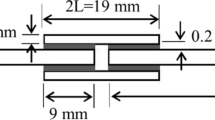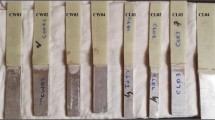Abstract
Adhesively bonded repairs are frequently used to repair aluminum structures due to their attractive options compared to traditional methods such as welding or riveting. A new method of increasing the repair’s strength against uniaxial tensile loads is used in this study. For this purpose, standard single-strap (SS) and double-strap (DS) repairs were produced with aluminum patch. In the first step, an epoxy-based adhesive was employed to create SS and DS repairs using neat adhesive and 0.5 wt.% reduced graphene oxide (RGO)-reinforced adhesive. Afterward, samples of SS and DS joints with the reinforced adhesive were manufactured to study the effect of the added RGO. Uniaxial tensile tests were conducted and above 30% enhancement in the ultimate load was observed in the joints bonded with reinforced adhesive. The repaired joints were analyzed by finite element (FE) method using cohesive zone modeling technique to obtain failure loads. For this purpose, two sets of tests (a) double cantilever beam and (b) end notch flexure tests were implemented to estimate the cohesive zone model CZM parameters. Comparing the results obtained from experiments and the numerical simulations shows that FE models accurately predict the failure load in the reinforced and unreinforced repaired joints.












Similar content being viewed by others
Abbreviations
- B :
-
Specimen width
- D :
-
Diagonal matrix
- I :
-
Identity matrix
- G IIC :
-
Energies released (mode II)
- G IC :
-
Energies released (mode I)
- p :
-
Applied load
- T I :
-
Maximum normal nominal stress
- T II :
-
Maximum shear nominal stress
- δ :
-
Vector of relative displacement
- δ i :
-
Current damage relative displacement in mode I
- δ o,i :
-
Onset damage relative displacement in mode II
- υ :
-
Poisson’s ratio
References
E. Marques, L.F. da Silva, Joint strength optimization of adhesively bonded patches. J. Adhes. 84(11), 915–934 (2008)
B.B. Bouiadjra, H. Fekirini, M. Belhouari, B. Boutabout, B. Serier, Fracture energy for repaired cracks with bonded composite patch having two adhesive bands in aircraft structures. Comput. Mater. Sci. 40(1), 20–26 (2007)
A. Pinto, R. Campilho, I.R. Mendes, A. Baptista, Strap repairs using embedded patches: numerical analysis and experimental results. J. Adhes. Sci. Technol. 28(14–15), 1530–1544 (2014)
Ş. Çitil, Ş. Temiz, H. Altun, A. Özel, Determination of mechanical properties of double-strap adhesive joints with an embedded patch. J. Adhes. Sci. Technol. 25(18), 2555–2567 (2011)
Ş. Temiz, Application of bi-adhesive in double-strap joints subjected to bending moment. J. Adhes. Sci. Technol. 20(14), 1547–1560 (2006)
A. Pinto, R. Campilho, I. Mendes, A. Baptista, Strap repairs using embedded patches: numerical analysis and experimental results. J. Adhes. Sci. Technol. 28(14–15), 1530–1544 (2014)
S. Iijima, Helical microtubules of graphitic carbon. Nature 6348(48), 56–58 (1991)
E. Flahaut, A. Peigney, C. Laurent, C. Marliere, F. Chastel, A. Rousset, Carbon nanotube-metal-oxide nanocomposites: microstructure, electrical conductivity and mechanical properties. Acta Mater. 48(14), 3803–3812 (2000)
Y. Geng, M.Y. Liu, J. Li, X.M. Shi, J.K. Kim, Effects of surfactant treatment on mechanical and electrical properties of CNT/epoxy nanocomposites. Compos. Part A Appl. Sci. Manuf. 39(12), 1876–1883 (2008)
P.C. Ma, J.-K. Kim, B.Z. Tang, Functionalization of carbon nanotubes using a silane coupling agent. Carbon 44(15), 3232–3238 (2006)
J. Zhu, J. Kim, H. Peng, J.L. Margrave, V.N. Khabashesku, E.V. Barrera, Improving the dispersion and integration of single-walled carbon nanotubes in epoxy composites through functionalization. Nano Lett. 3(8), 1107–1113 (2003)
P. Karapappas, A. Vavouliotis, P. Tsotra, V. Kostopoulos, A. Paipetis, Enhanced fracture properties of carbon reinforced composites by the addition of multi-wall carbon nanotubes. J. Compos. Mater. 43(9), 977–985 (2009)
K.D.S. Davey, Development of Carbon Nanotube/Carbon Fiber Multiscale Reinforcement Composites, Electronic Theses, Treatises and Dissertations Paper 823 (2005)
F.H. Gojny, M.H. Wichmann, B. Fiedler, K. Schulte, Influence of different carbon nanotubes on the mechanical properties of epoxy matrix composites—a comparative study. Compos. Sci. Technol. 65(15), 2300–2313 (2005)
S. Jana, W.-H. Zhong, Y.X. Gan, Characterization of the flexural behavior of a reactive graphitic nanofibers reinforced epoxy using a non-linear damage model. Mater. Sci. Eng. A 445, 106–112 (2007)
Y.J. Kim, T.S. Shin, C.H. Do, J.H. Kwon, Y.-C. Chung, H.G. Yoon, Electrical conductivity of chemically modified multiwalled carbon nanotube/epoxy composites. Carbon 43(1), 23–30 (2005)
M. Rahman, S. Zainuddin, M. Hosur, J. Malone, M. Salam, A. Kumar et al., Improvements in mechanical and thermo-mechanical properties of e-glass/epoxy composites using amino functionalized MWCNTs. Compos. Struct. 94(8), 2397–2406 (2012)
M.-H. Kang, J.-H. Choi, J.-H. Kweon, Fatigue life evaluation and crack detection of the adhesive joint with carbon nanotubes. Compos. Struct. 108, 417–422 (2014)
G. Gkikas, D. Sioulas, A. Lekatou, N. Barkoula, A. Paipetis, Enhanced bonded aircraft repair using nano-modified adhesives. Mater. Des. 41, 394–402 (2012)
J. Kim, B.-S. Yim, J.-M. Kim, J. Kim, The effects of functionalized graphene nanosheets on the thermal and mechanical properties of epoxy composites for anisotropic conductive adhesives (ACAs). Microelectron. Reliab. 52(3), 595–602 (2012)
U. Khan, P. May, H. Porwal, K. Nawaz, J.N. Coleman, Improved adhesive strength and toughness of polyvinyl acetate glue on addition of small quantities of graphene. ACS Appl. Mater. Interfaces 5(4), 1423–1428 (2013)
S. Abdolhosseinzadeh, H. Asgharzadeh, H.S. Kim, Fast and fully-scalable synthesis of reduced graphene oxide. Sci. Rep. 5, 10160 (2015)
M.A.S. Sadigh, G. Marami, Bearing and cleavage failure simulation of single lap bolted joint using finite element method. Trans. Indian Inst. Met. 69(8), 1613–1622 (2016)
M.A.S. Sadigh, G. Marami, Investigating the effects of reduced graphene oxide additive on the tensile strength of adhesively bonded joints at different extension rates. Mater. Des. 92, 36–43 (2016)
R. Campilho, M.D. Banea, A. Pinto, L.F. da Silva, A. De Jesus, Strength prediction of single-and double-lap joints by standard and extended finite element modelling. Int. J. Adhes. Adhes. 31(5), 363–372 (2011)
P. Hu, X. Han, W. Li, L. Li, Q. Shao, Research on the static strength performance of adhesive single lap joints subjected to extreme temperature environment for automotive industry. Int. J. Adhes. Adhes. 41, 119–126 (2013)
L.F. da Silva, T. Rodrigues, M. Figueiredo, M. De Moura, J. Chousal, Effect of adhesive type and thickness on the lap shear strength. J. Adhes. 82(11), 1091–1115 (2006)
M. De Moura, J. Gonçalves, J. Chousal, R. Campilho, Cohesive and continuum mixed-mode damage models applied to the simulation of the mechanical behaviour of bonded joints. Int. J. Adhes. Adhes. 28(8), 419–426 (2008)
M. de Moura, J. Gonçalves, A. Magalhães, A straightforward method to obtain the cohesive laws of bonded joints under mode I loading. Int. J. Adhes. Adhes. 39, 54–59 (2012)
G. Marami, S.A. Nazari, S.A. Faghidian, F. Vakili-Tahami, S. Etemadi, Improving the mechanical behavior of the adhesively bonded joints using RGO additive. Int. J. Adhes. Adhes. 70, 277–286 (2016)
Author information
Authors and Affiliations
Corresponding author
Rights and permissions
About this article
Cite this article
Saeimi Sadigh, M.A. Enhanced Failure Load Bearing in Adhesively Bonded Strap Repairs: Numerical Analysis and Experimental Results. J Fail. Anal. and Preven. 19, 182–192 (2019). https://doi.org/10.1007/s11668-019-00589-y
Received:
Revised:
Published:
Issue Date:
DOI: https://doi.org/10.1007/s11668-019-00589-y




